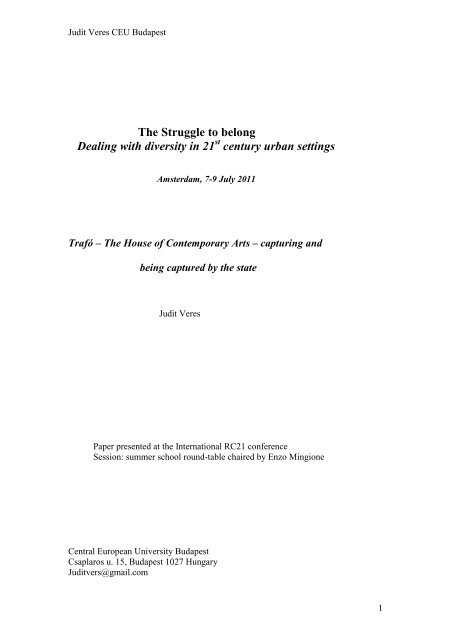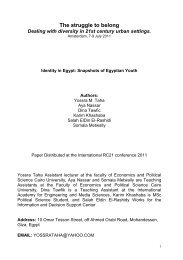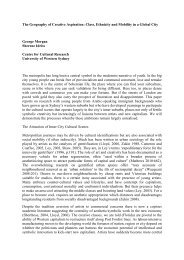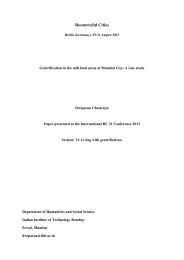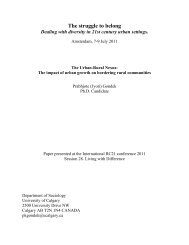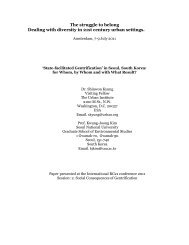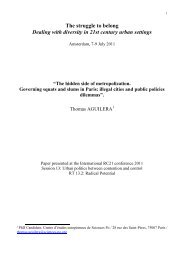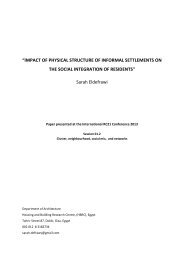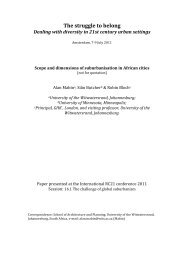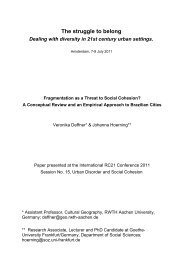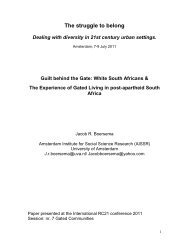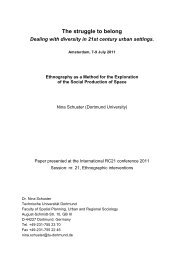Gentrification as a broad process of reurbanization - RC21 ORG ...
Gentrification as a broad process of reurbanization - RC21 ORG ...
Gentrification as a broad process of reurbanization - RC21 ORG ...
Create successful ePaper yourself
Turn your PDF publications into a flip-book with our unique Google optimized e-Paper software.
Judit Veres CEU Budapest<br />
The Struggle to belong<br />
Dealing with diversity in 21 st century urban settings<br />
Amsterdam, 7-9 July 2011<br />
Trafó – The House <strong>of</strong> Contemporary Arts – capturing and<br />
being captured by the state<br />
Judit Veres<br />
Paper presented at the International <strong>RC21</strong> conference<br />
Session: summer school round-table chaired by Enzo Mingione<br />
Central European University Budapest<br />
Csaplaros u. 15, Budapest 1027 Hungary<br />
Juditvers@gmail.com<br />
1
Judit Veres CEU Budapest<br />
Trafó - the House <strong>of</strong> Contemporary Arts – capturing and being captured<br />
by the state.<br />
Abstract<br />
In this paper I propose to analyse the emergence and evolution <strong>of</strong> one particular urban<br />
cultural space in Budapest, The House <strong>of</strong> Contemporary Arts, more commonly known<br />
by the moniker Trafó. This attempt is part <strong>of</strong> a larger project that encomp<strong>as</strong>ses five<br />
urban cultural spaces that have emerged in post-socialist Budapest for the p<strong>as</strong>t 20<br />
years with histories that go back well before these times. I regard these urban cultural<br />
spaces <strong>as</strong> part <strong>of</strong> the global urban phenomenon that sees derelict urban industrial sites<br />
revamped into chic post-industrial urban cultural venues. Each <strong>of</strong> these urban spaces<br />
in various ways have re-enacted this pattern, but each instance I argue, presents yet<br />
again modified practices and meanings, and thus together they constitute a wider<br />
dynamic field symptomatic <strong>of</strong> a wider urban socio-spatial restructuring <strong>of</strong> postsocialist<br />
Budapest. I approach these urban cultural spaces <strong>as</strong> representation and<br />
synecdoche <strong>of</strong> the city, <strong>as</strong> a locus for understanding intersections <strong>of</strong> <strong>broad</strong>er concerns<br />
facing urban residents and scholars alike, including social relations, public space and<br />
civic life, privatization and state formation, and economic and cultural globalization.<br />
Interestingly, all these cultural centres are public institutions with the state deeply<br />
implicated in their formation. Their history is that <strong>of</strong> over-politicized urban spaces at<br />
the intersection <strong>of</strong> which various power struggles have been waged not simply over<br />
their place and meaning in the urban fabric <strong>of</strong> post-socialist Budapest, but over<br />
practices and visions in the larger urban context at the intersection <strong>of</strong> spheres <strong>of</strong><br />
influence <strong>of</strong> state, economic and civil society actors. Their histories, I argue, are<br />
embedded in and reflect relevant urban dynamics <strong>of</strong> Budapest for the p<strong>as</strong>t two<br />
decades, in particular with respect to urban cultural politics and the urban regulatory<br />
context. Their dynamics shed light on the cultural political economy <strong>of</strong> the city; on<br />
the redrawing <strong>of</strong> public space and publics in a largely post-political condition,<br />
destabilizing the public-private analytic division; on various practices forming<br />
neoliberal subjects against the larger <strong>process</strong>es <strong>of</strong> democratization, neoliberal<br />
privatization and free-market creation. All these entail the continuous rewriting <strong>of</strong> the<br />
2
Judit Veres CEU Budapest<br />
role and purview <strong>of</strong> the state, the economic and the civil society sphere very much<br />
complicating any neat analytical formulations and delimitations.<br />
Introduction<br />
For the p<strong>as</strong>t few decades one‘s retinal and emotional experience <strong>of</strong> cities h<strong>as</strong> shifted<br />
and attempts to account for this experience have been <strong>of</strong>ten expressed in terms <strong>of</strong> a<br />
structural shift from an industrial to postindustrial society, or/and <strong>as</strong> part <strong>of</strong> a shift<br />
from a city <strong>of</strong> production to a city <strong>of</strong> consumption. One <strong>of</strong> the most visible changes in<br />
the fabric <strong>of</strong> cities h<strong>as</strong> been the appearance <strong>of</strong> revamped post-industrial buildings,<br />
<strong>of</strong>ten transformed into urban cultural centres. These pockets <strong>of</strong> urban regeneration<br />
have mushroomed alongside many other urban developmental projects, presumably<br />
intricately related to them, and not le<strong>as</strong>t alongside and in conjunction with ruined and<br />
impoverished urban sites. Within a neoliberalizing urban political economy urban<br />
policies have prioritized economic development and not wealth distribution, area<br />
interventions and not universal policies, and individual projects and not a more<br />
encomp<strong>as</strong>sing planning context. This is best encapsulated by the penchant for<br />
‗emblematic projects‘ that ‗capture a segment <strong>of</strong> the city and turn it into the symbol <strong>of</strong><br />
the new restructured/revitalized metropolis‘ (Swygendouw et al., 2002; 562) with the<br />
state <strong>as</strong> one <strong>of</strong> the determining actors in the <strong>process</strong> (Swyngedouw, ibid.).<br />
Cities across the world, which have undertaken such urban regeneration projects, have<br />
been <strong>of</strong>ten presented <strong>as</strong> conferring on culture, and more particularly, on cultural<br />
centres, seemingly, a quite central role. If one thinks <strong>of</strong> Bilbao‘s Guggenheim, or<br />
Vienna‘s Museums Quartier, just to name these two very different instances, the<br />
question what these cultural sites have meant and done, beyond what the catch word<br />
‗urban regeneration through culture‘ might entail, in their immediate and larger urban<br />
context becomes a much more complicated issue to be understood and dissected.<br />
In my analysis I draw on the so-called ‗new urban sociology‘ that h<strong>as</strong> elaborated an<br />
explicitly spatialized and reflexively multi-scalar understanding <strong>of</strong> capitalist<br />
urbanization (Brenner 2004, Swyngedouw, Moulaert & Rodriguez 2005) the latter<br />
conceived <strong>as</strong> outcome <strong>of</strong> the uneven geographical development (Harvey 1990, 2005,<br />
2008, M<strong>as</strong>sey 1995, Smith 1996, 2002). The two major schools within radical urban<br />
3
Judit Veres CEU Budapest<br />
studies such <strong>as</strong> the institutionalist (Amin, Scott, Thrift etc.) and regulationist (Jessop,<br />
Jones, Peck, Tickell) have extensively analyzed urban restructuring in relation to<br />
recent political-economic changes commonly referred to <strong>as</strong> neoliberalism <strong>of</strong>fering<br />
many insights. However, these macro political economic analyses have not yet<br />
addressed in-depth the more specific question <strong>of</strong> culture, <strong>of</strong> cultural uses <strong>as</strong> an<br />
essential part <strong>of</strong> the political economy <strong>of</strong> cities. Bob Jessop h<strong>as</strong> taken up the question<br />
<strong>of</strong> semiotics in cultural political economy and h<strong>as</strong> indeed argued for the relevancy <strong>of</strong><br />
a cultural urban political economy. It h<strong>as</strong> been most importantly Sharon Zukin who<br />
h<strong>as</strong> compellingly combined cultural and political economy approaches to the<br />
understanding <strong>of</strong> cities among some other scholars who have variously written on<br />
recent transformations <strong>of</strong> the built environment in postindustrial cities <strong>as</strong> cultural<br />
urban strategies deployed in economic development (Boyer 1992; Deutsche, 1996;<br />
Fainstein, 1994, 2001, 2008; Low, 2000, 2003, 2006; Soja, 1989; Sorkin, 1992). The<br />
inherited institutional frameworks and policy regimes in a post-socialist context<br />
where a command economy h<strong>as</strong> been gradually transformed into a market economy<br />
have been rarely combined with an understanding <strong>of</strong> the built environment, with an<br />
explicit urban focus (Bodnár, 2001, Szelényi 1996, Tosics 2005, 2006) to name a but<br />
few exceptions.<br />
Through this project I hope to contribute to the understanding <strong>of</strong> the ways in which<br />
culture, economy and politics have been redefined for the p<strong>as</strong>t few decades in this<br />
particular post socialist context in the light <strong>of</strong> the marketization <strong>process</strong>, no doubt one<br />
<strong>of</strong> the most important <strong>process</strong>es in post socialist countries. Against an overwhelming<br />
and abstract notion <strong>of</strong> marketization, <strong>of</strong> market making an ethnographic approach to<br />
these urban cultural spaces will allow for a more precise understanding <strong>of</strong> the changed<br />
role <strong>of</strong> the state, the commercialization <strong>of</strong> culture and urban space, an their<br />
entanglement with cultural and urban policies.<br />
I conceive my approach in terms <strong>of</strong> a preoccupation with the relations between space,<br />
culture and political economy <strong>of</strong> the city. I am interested in how urban space is<br />
produced, what kind <strong>of</strong> culture is being expressed in the built environment, whose<br />
culture is being promoted, to what ends, and what social, political and economic<br />
rationalities get constructed along the production <strong>of</strong> space <strong>as</strong> part <strong>of</strong> the recent sociospatial<br />
urban restructuring. In this respect I find cultural political economy <strong>as</strong> a<br />
cultural perspective on the city that also takes material-economic matters seriously<br />
4
Judit Veres CEU Budapest<br />
approaching social <strong>process</strong>es <strong>as</strong> co-constituted by cultural, political and economic<br />
<strong>process</strong>es quite inspiring and helpful to my endeavor.<br />
In this paper I propose to look at the historical emergence <strong>of</strong> one particular urban<br />
cultural space known <strong>as</strong> Trafó, at the sociopolitical ideologies and economic forces<br />
involved in its production, including the role played by cultural entrepreneurs, state<br />
<strong>of</strong>ficials in its formation, the social use <strong>of</strong> the place, and its <strong>as</strong>sociated symbolic and<br />
affective meanings.<br />
Contrary to widespread <strong>as</strong>sumptions about the hollowing out <strong>of</strong> and the demise <strong>of</strong> the<br />
state, Trafó‘s history presents a more nuanced and dynamic picture <strong>of</strong> a continuously<br />
evolving relationship between state and capital and society. I start from the idea that<br />
― actually existing socialism and welfare systems in the West should be conceived not<br />
<strong>as</strong> fundamentally different social formations but <strong>as</strong> importantly different variations <strong>of</strong><br />
the general state-interventionist form <strong>of</strong> twentieth century world capitalism‖ (Moishe<br />
Postone, 1993) A far from monolithic or static post-socialist state h<strong>as</strong> emerged out <strong>of</strong><br />
the socialist state, one that h<strong>as</strong> variously steered and intervened in the movement <strong>of</strong><br />
capital, but in a way that best served the interests <strong>of</strong> the always dominant political<br />
parties. The changes <strong>of</strong> the Hungarian socialist state into a neo-liberal capitalist state<br />
show that the state does not vanish, but that its main logic transforms, and those parts<br />
that are thought to strengthen it dominate the political <strong>process</strong>. The recent debates on<br />
and changes in governing in the wake <strong>of</strong> the 2010 elections need to be seen in light <strong>of</strong><br />
this and that the new modes <strong>of</strong> neoliberal governances are not, by far, more<br />
democratic or participatory but seem to point to more exclusionary, authoritarian and<br />
intransparent political structures, actor-constellations and policy-making.<br />
No alternatives and independents in the new urban politics after the 2010 elections?<br />
‘ When the Alliance <strong>of</strong> Free Democrats took over cultural politics twenty years ago<br />
they turned the order <strong>of</strong> values on their head and with this they caused unbelievable<br />
destruction. The t<strong>as</strong>k <strong>of</strong> the current government is to turn the order <strong>of</strong> values back on<br />
their feet’. (Iván Markó, Magyar Hírlap)<br />
This remark by one <strong>of</strong> courtiers to the current right wing establishment, and who is<br />
rumoured to get Trafo, w<strong>as</strong> made apropos <strong>of</strong> the looming changes with respect to<br />
5
Judit Veres CEU Budapest<br />
changes around Trafo and it well captures the widespread view among right wing<br />
politicians and supporters <strong>of</strong> the former liberal and left wing urban cultural politics.<br />
After months <strong>of</strong> rumours and speculations the decision to hand over Trafo, a more<br />
alternative cultural urban space in Budapest, from the municipality <strong>of</strong> Budapest to the<br />
state h<strong>as</strong> been eventually made. The new deputy-mayor <strong>of</strong> Budapest responsible for<br />
cultural and educational matters h<strong>as</strong> announced that Trafo will indeed belong to the<br />
state, but declined to reveal any details about its further functioning, whether a pr<strong>of</strong>ile<br />
change will occur or not, or who will be in charge, with the excuse that once the<br />
cultural venue h<strong>as</strong> been declared to become a state institution, the city does not posses<br />
any further information on the details <strong>of</strong> its future functioning. However, he refuted<br />
the rumour, which h<strong>as</strong> been circulating for months by now, that Trafo will be merged<br />
with PeCsa.<br />
In the wake <strong>of</strong> the 2010 general elections a right wing government replaced the<br />
socialists securing a two-third parliamentary majority. In the subsequent local<br />
elections the right wing contender defeated the liberal mayor who governed the city<br />
for 20 years.<br />
The new political establishment h<strong>as</strong> been accusing the former government <strong>of</strong> pushing<br />
the country to the brink <strong>of</strong> ruin by inflating the public debt to record heights with its<br />
laissez faire attitude and with a corrupt and venal cohort at the helm. Under the<br />
welcome pretext to remedy this situation the conservative government h<strong>as</strong> taken an<br />
unprecedented series <strong>of</strong> anti-democratic me<strong>as</strong>ures, sanctioned by the two-third<br />
parliamentary majority. Among others it h<strong>as</strong> rewriten the constitution without any<br />
consultation with and participation <strong>of</strong> the opposition or <strong>of</strong> any pr<strong>of</strong>essional interest<br />
groups whatsoever, dr<strong>as</strong>tically curbing the rights <strong>of</strong> the citizens, criminalizing poverty<br />
to an unprecedented degree, and virtually ending all balances and checks on its power.<br />
In the current political climate several replacements have taken place and top and mid<br />
and rank-and-file positions have been filled with people supposed to be loyal to the<br />
present government.<br />
In conjunction with personal changes, which have been largely completed by now, an<br />
attempt at a complete overhaul <strong>of</strong> the current state apparatus is taking place the end <strong>of</strong><br />
which is hard to be predicted. The complete administrative, regulatory system is being<br />
rethought, restructuring the relationship between Budapest and the state and the<br />
6
Judit Veres CEU Budapest<br />
smaller towns, <strong>of</strong> the districts <strong>of</strong> the capital to the municipality, and reshuffling the<br />
counties and regions. There is a plethora <strong>of</strong> initiatives, policy recommendations,<br />
regulations and laws all advanced by the governing party, which at this stage all point<br />
towards a consolidation <strong>of</strong> this governing elite‘s grip on power.<br />
One <strong>as</strong>pect <strong>of</strong> this frenzy <strong>of</strong> consolidating one‘s grip one power is the obvious<br />
preoccupation with symbolic and affective practices <strong>of</strong> place making, <strong>of</strong> control <strong>of</strong><br />
visual images, most immediately noticeable in the renaming <strong>of</strong> streets and public<br />
squares; Roosevelt square becoming Széchenyi square and Moszkva square renamed<br />
Széll Kálmán square, in changing or disciplining the directors <strong>of</strong> the most prestigious<br />
cultural institutions etc. This happens against a larger context <strong>of</strong> economic and<br />
cultural globalization when the promoting <strong>of</strong> culture to cities in its various guises,<br />
such <strong>as</strong> a Guggenheim museum, or a Tate Modern, or <strong>as</strong> the preservation <strong>of</strong><br />
architectural landmarks or various forms <strong>of</strong> cultural heritage, <strong>as</strong> a cultural strategy <strong>of</strong><br />
economic development points towards an entrepreneurialism <strong>as</strong> a speculative<br />
construction <strong>of</strong> place in the sense that all these strategies are meant to attract and<br />
promote flows <strong>of</strong> mobile international capital and tourism through branding and<br />
selling an attractive city to investors and visitors.<br />
“The turn <strong>of</strong> the century are the years <strong>of</strong> development, <strong>of</strong> industrialization, Budapest is born at this<br />
time, and immediately becomes a really big city, a bit bigger than itself― (Péter Esterházy, p. 195, my<br />
translation).<br />
―Everybody w<strong>as</strong> born at that time; Joyce, Musil, Broch, Rilke, Thom<strong>as</strong> Mann, Kafka, Einstein, Pic<strong>as</strong>so,<br />
Wittgenstein, everybody who mattered w<strong>as</strong> there at their cradle, “tout Paris“ . The so-called<br />
Hungarian cl<strong>as</strong>sics come from that time, too; Ady Endre, Babits Mihály, Móricz Zsigmond, Juhász<br />
Gyula, K<strong>as</strong>sák Lajos, Bartók, Kodály. At the rurn <strong>of</strong> the century everything worked out beautifully.<br />
Before the world collapsed, everything just worked out beautifully.― (ibid)<br />
In March 2011 a roundtable discussion took place about the necessity to rethink the<br />
mid- and long-term urban development strategies <strong>of</strong> Budapest, gathering planners,<br />
architects, mayors, journalists etc. with the aim to define the future vision, the brand<br />
that can sell Budapest well to tourists and investors.<br />
One <strong>of</strong> the participants‘ remark somehow resonates with the Esterhazy quote above,<br />
when remarking the fact that Budapest, although <strong>of</strong>ten compared to either Vienna,<br />
7
Judit Veres CEU Budapest<br />
Berlin or Paris, in fact, resembles only two cities and those are Barcelona and New<br />
York. And it does so with respect to the fact that Budapest just like Barcelona and<br />
New York w<strong>as</strong> built during one, one and a half generation. ‗Budapest <strong>as</strong> a concept is<br />
the creation <strong>of</strong> the wonderful period between 1867-1918, when out <strong>of</strong> two small<br />
towns a fant<strong>as</strong>tic world city w<strong>as</strong> born‘. (P. Szucs Julianna, Mozgovilag, 2011)<br />
Whether this is a rhetorical flourish or not, the historical core <strong>of</strong> the city is indeed<br />
made up <strong>of</strong> buildings constructed during the aforementioned period and presents a<br />
fairly intact and well-preserved turn-<strong>of</strong>-the-century eclectic architectural heritage. For<br />
the p<strong>as</strong>t year it w<strong>as</strong> around this architectural and cultural heritage that a series <strong>of</strong><br />
demonstrations (most <strong>of</strong> the times gathering 20-100 people only), petitions and<br />
discussion have happened, situation that is rather new in Budapest <strong>as</strong> most people<br />
show little else than indifference at the prospect <strong>of</strong> some buildings being demolished<br />
or about urban politics in general.<br />
In the summer <strong>of</strong> 2010 a real estate developer invited Foster & Partners to design an<br />
iconic building in the historical centre <strong>of</strong> the city, a kind <strong>of</strong> skyscraper housing <strong>of</strong>fices<br />
and a luxury hotel in the form <strong>of</strong> a zeppelin hovering above the city, building which<br />
would have entailed the er<strong>as</strong>ure <strong>of</strong> five historical buildings. A huge debate reaching a<br />
wider public ensued raising questions <strong>of</strong> accountability, transparency and democratic<br />
participation among other things. The young conservative mayor <strong>of</strong> the district turned<br />
out to be quite supportive <strong>of</strong> the project, despite earlier vociferously arguing for the<br />
contrary, for the preservation <strong>of</strong> the built heritage against any land speculation. It w<strong>as</strong><br />
not only the zeppelin, but also the idea <strong>of</strong> designing a museum quarter, then a new<br />
bridge cum shopping mall linking Pest and Buda - which would hopefully improve<br />
the market prospects <strong>of</strong> the real-estate development known <strong>as</strong> the Millennium City<br />
Centre owned by the same real estate mogul who would own the new shopping mall<br />
on the bridge – that brought to the public attention more than even before the fate <strong>of</strong><br />
the built environment, and it showed more starkly than ever that this w<strong>as</strong> about social<br />
and cultural conflict, about economic and state might and about the right to the city in<br />
general. As quickly <strong>as</strong> it reached public awareness the whole issue subsided, crushed<br />
by other more pressing concerns.<br />
However, the question <strong>of</strong> the future <strong>of</strong> Trafó, have resurfaced again and again, and the<br />
new Budapest city council have dealt with the subject on several occ<strong>as</strong>ions. One thing<br />
h<strong>as</strong> become clear, though; this supposedly more alternative urban cultural space does<br />
not seem to e<strong>as</strong>ily fit the conservative ideology <strong>of</strong> the current establisment. It either<br />
8
Judit Veres CEU Budapest<br />
h<strong>as</strong> to change its pr<strong>of</strong>ile under the current leadership, choice that it is difficult to<br />
explain, or under a new leadership it will be something else. Either way it will ce<strong>as</strong>e<br />
to be Trafó <strong>as</strong> it is currently. The issue seems to be clear: the former Budapest<br />
leadership supported smaller and indipendent theaters and more alternative urban<br />
cultural spaces. The current leadership wants none <strong>of</strong> these.<br />
Trafó is the result <strong>of</strong> years <strong>of</strong> work and lobbying on the part <strong>of</strong> its current director. It<br />
is also the outcome <strong>of</strong> an urban political context that for twenty years w<strong>as</strong> led by a<br />
liberal mayor belonging to the Alliance <strong>of</strong> Free Democrats, one <strong>of</strong> the four parties that<br />
forged the democratic transition. No matter which party captured the state the capital<br />
w<strong>as</strong> run under a liberal leadership for twenty years. The political parties which<br />
dominated state institutions did affect the urban politics <strong>of</strong> the capital and many times<br />
it complicated their smooth functioning, nevertheless the liberal free democrats<br />
managed to keep the capital till 2010.<br />
A post-industrial cultural urban space builds up a narrative <strong>of</strong> a subversion<br />
Mills, granaries and electricity<br />
As a electric power transformer, Trafó‘s history goes back to the turn <strong>of</strong> the previous<br />
century. Three out <strong>of</strong> the five urban cultural spaces I proposed to look at are found in<br />
the ninth district <strong>of</strong> Budapest. In this piece <strong>as</strong> I already mentioned I focus on only one<br />
<strong>of</strong> them, namely Trafó. The other two MuPa and CET, the latter still under<br />
construction, and seemingly one <strong>of</strong> the first iconic buildings <strong>of</strong> the city, lie in the area<br />
<strong>of</strong> Ferencváros, where at the turn <strong>of</strong> the previous century rows <strong>of</strong> modern mills,<br />
granaries and warehouses used to be.<br />
The most decisive period in the urban development <strong>of</strong> Budapest, and Ferencváros, the<br />
ninth district <strong>of</strong> Budapest, is considered to be between the second half <strong>of</strong> the<br />
nineteenth century and the first quarter <strong>of</strong> the twentieth century.<br />
It is in the first quarter <strong>of</strong> the nineteenth century that crop and grain merchants start to<br />
get settled in large numbers in Pest, considered an important commercial centre. In<br />
the hope for larger pr<strong>of</strong>its these merchants start investing their accumulated capital<br />
into milling, making it the leading sector for the Hungarian industry for decades. The<br />
rows <strong>of</strong> the modern mills replacing the boat mills along the Danube become the<br />
symbol <strong>of</strong> the capital by the second half <strong>of</strong> the nineteenth century. The name <strong>of</strong> the<br />
9
Judit Veres CEU Budapest<br />
‗stomach <strong>of</strong> Budapest‘ given to Ferencváros is partly due to the large number <strong>of</strong> mills<br />
which makes Budapest the second-largest grain-<strong>process</strong>ing centre <strong>of</strong> the world by the<br />
turn <strong>of</strong> the century. The first large mill, Concordia, is built in 1867, followed by the<br />
Mill <strong>of</strong> Millers and Bakers <strong>of</strong> Budapest (the main shareholders being millers, bakers<br />
and flour merchants, employing 200 workers at the end <strong>of</strong> the century), the Gizella<br />
(400 people in 1896) and Király (Royal Steam Mill Hedrich and Strauss its<br />
modernization reaching into the 1990s, today called Ferencváros Mill), and Hungaria<br />
in 1893, today protected <strong>as</strong> a listed landmark building. The former Concordia Mill<br />
functions <strong>as</strong> the Museum <strong>of</strong> Mill Industry.<br />
The late 19th century also means a rapid progress in electrical engineering after<br />
centuries <strong>of</strong> scientific curiosity and electricity becomes the driving force <strong>of</strong> the<br />
Second Industrial Revolution. Electrical transformers greatly influence the electricitysupplied<br />
industry, allowing for the economic transmission <strong>of</strong> power over long<br />
distances, generation to be located remotely from points <strong>of</strong> demand. The big majority<br />
<strong>of</strong> transformers used today rely on b<strong>as</strong>ic principles discovered by the three engineers<br />
at Ganz corporations – Ottó Bláthy, Miksa Déri, Károly Zipernowsky. One part <strong>of</strong> the<br />
former Ganz buildings is reopened <strong>as</strong> the Millenáris cultural and scientific centre in<br />
2001.<br />
The would-be Trafó (The House <strong>of</strong> Contemporary Arts), the electric transformer in<br />
Liliom Street w<strong>as</strong> built in 1909 by Grestenberger Ágost and Arvé Károly (the first<br />
generator in the area w<strong>as</strong> built in 1893 in Kazinczy street 21 – today The Museum <strong>of</strong><br />
Electricity).<br />
It w<strong>as</strong> modernized in 1934, modified and extended sometime after 1945, and it w<strong>as</strong> in<br />
the 1960s that the building closed and fell to neglect. In 1961 the building w<strong>as</strong><br />
nationalized, and in 1978 the Budapest Liquor Company took over the maintenance <strong>of</strong><br />
the empty building. In 1989 the Hungarian Credit bank purch<strong>as</strong>ed the decayed<br />
powerhouse, and then Metra Limited Company, bought and used it for some time <strong>as</strong> a<br />
shop doing some renovations on some <strong>of</strong> its parts thus slowing its rapid decay,<br />
reflecting the ‗ground-floor capitalism‘ <strong>of</strong> the time - the rapid establishment <strong>of</strong> shops<br />
(Tosics, 2006), even outside the downtown. It w<strong>as</strong> during this time that squatters<br />
discovered the place and moved in before the municipality eventually bought it in<br />
10
Judit Veres CEU Budapest<br />
1994. It w<strong>as</strong> during these years that that an agreement seems to have emerged on<br />
revamping the powerhouse into a cultural venue.<br />
The political and infr<strong>as</strong>tructural support <strong>of</strong> the district‗s industrial heyday w<strong>as</strong> long<br />
gone when, after years <strong>of</strong> neglect, around the middle <strong>of</strong> the eighties the early nineties<br />
feeble signs <strong>of</strong> development began to emerge, before it gained momentum by the late<br />
90s and reached its full impact under the district mayor, who ran the district for 20<br />
years until losing the local elections in 2010.<br />
At the beginning <strong>of</strong> the nineties squatting appeared in some districts <strong>of</strong> Budapest. One<br />
such instance w<strong>as</strong> in Ferencváros in Liliom Street. Several newspapers in 1991 wrote<br />
about the French squatters in Ferencvaros Liliom Street 41 and many people these<br />
days too reminisce about the funny, carnivalesque look this part <strong>of</strong> the street took at<br />
that time. When one thinks <strong>of</strong> the dull decayed grey concrete and brick buildings in a<br />
socialist city one may get an inkling what impression the colorfully painted bus<br />
hanging from a lamppost might have made on p<strong>as</strong>sers-by, not to speak about the<br />
artistic performances going on inside.<br />
“A place opened in Budapest a couple <strong>of</strong> months ago. At the beginning I liked this<br />
f***empty building, the discarded burnt out bus hanging from a lamppost, the huge<br />
cellar system. But then my enthusi<strong>as</strong>m faded <strong>as</strong> I realized that all the squatters, the<br />
anarchists, the alternatives are just a bunch <strong>of</strong> primitive scum. This is a really<br />
alternative place for self-realization, which amounts to painting band names on the<br />
wall. There w<strong>as</strong> a stuck-up snob monkey – a French guy and the entire squat - like old<br />
good anarchists - were continuously adulating him. Yes, these manful anarchists are<br />
spiritually on the same level <strong>as</strong> an average housewife kowtowing when the American<br />
relatives come for a visit“. (a p<strong>as</strong>ser-by, newspaper clip, Trafó)<br />
“People living in Ferencvaros are rubbing their eyes with disbelief. A French artist<br />
group with quite a startling look have solved their housing problem in Budapest in an<br />
<strong>as</strong>tounding way: they simply singled out an out-<strong>of</strong>-use building and just moved in<br />
there. …..Most <strong>of</strong> the people in the neighborhood welcome these strange newcomers,<br />
but there are some hostile reactions too. Their exhibition a couple <strong>of</strong> meters away<br />
from the squat h<strong>as</strong> been burnt down and the “intruders“ have been called upon to<br />
leave.“ (Czene Gabor, 1991, Junius 12, szerda, Mai Nap)<br />
11
Judit Veres CEU Budapest<br />
If one looks at the period preceding the opening <strong>of</strong> Trafó, the single most publicized<br />
event in the history <strong>of</strong> the building, besides the various changes in ownership which<br />
went unnoticed, w<strong>as</strong> the illegal occupation by a French anarchist group, later followed<br />
by Hungarian squatters. The squatting-interlude not only altered a bit the atmosphere<br />
<strong>of</strong> an otherwise quite silent and deserted street breathing life into it and preparing it<br />
for its future gentrification but it lifted the house out <strong>of</strong> total obscurity. This w<strong>as</strong> how<br />
the would-be director <strong>of</strong> Trafó heard about it and who, just like many others, had been<br />
looking for a place that could accommodate artistic performances for quite some time.<br />
This is one <strong>of</strong> the several parts <strong>of</strong> the district that h<strong>as</strong> undergone m<strong>as</strong>sive regeneration,<br />
with entire streets and their hidden courtyards getting a full facelift by 2010.<br />
Ferencváros presents one <strong>of</strong> the most dynamic urban developments <strong>of</strong> the capital for<br />
the p<strong>as</strong>t 2-3 decades, although one would not necessarily consider it the prime<br />
location <strong>of</strong> Budapest to be developed and up-scaled. It is not exactly the downtown <strong>of</strong><br />
the city, neither the rich hilly inner districts, and yet it h<strong>as</strong> succeeded in performing<br />
one <strong>of</strong> the most visible changes in the urban fabric <strong>of</strong> the city. Its success is largely<br />
attributed to its entrepreneurial mayor who ran the district for almost 20 years <strong>as</strong> a<br />
free democrat similarly to the liberal mayor <strong>of</strong> Budapest. He managed to procure<br />
funds for renovating the bulk <strong>of</strong> the housing stock in the district, plus he supported the<br />
up-scaling <strong>of</strong> Ráday street.<br />
The squatters‗ time w<strong>as</strong> the harbinger <strong>of</strong> new beginnings, which in the c<strong>as</strong>e <strong>of</strong> Trafó<br />
meant 1998. However, some years had to p<strong>as</strong>s after the squatters had left for the<br />
house to open <strong>as</strong> a centre <strong>of</strong> contemporary arts and become what it is in fact up to<br />
these days.<br />
Cultural critique and opposition<br />
The structural link to the early twentieth century industrialism e<strong>as</strong>ily lends itself to<br />
constructing Trafó in terms <strong>of</strong> a post-industrial urban cultural space. However, what<br />
really made Trafó into a cult place w<strong>as</strong> its alleged link to a subersive, oppositional<br />
culture which dared critique the authoritarian Kádár socialist regime.<br />
Trafó is the legal successor to the legendary Young Artists‘ Club (FMK) on Andrássy<br />
boulevard. The Club/ FMK (Fiatal Művészek Klubja) established by the Budapest<br />
City Council in 1960 w<strong>as</strong> initiated by KISZ - the Young Hungarian Communist<br />
12
Judit Veres CEU Budapest<br />
League – (Magyar Kommunista Ifjúsági Szövetség) itself established in 1957, March<br />
27. It w<strong>as</strong> set up with the intention to <strong>of</strong>fer a place for Hungarian artists and<br />
intellectuals and it had acquired along the years the reputation <strong>of</strong> an underground<br />
cultural hub in the capital by the time it w<strong>as</strong> closed in the 90s. Considered by many to<br />
have significantly contributed to the emergence <strong>of</strong> the Hungarian artistic<br />
underground, it w<strong>as</strong> also one <strong>of</strong> the most closely observed cultural venues, and<br />
György Aczél himself the most influential person in the cultural policy <strong>of</strong> the Kádár<br />
era regarded it <strong>as</strong> a perfectly safe valve <strong>of</strong> expression. (true, by the eighties it w<strong>as</strong><br />
already possible to criticize the regime). It w<strong>as</strong> a place which w<strong>as</strong> more tolerated by<br />
the political establishment than other similar cultural venues such <strong>as</strong> the Almássy<br />
Hall, the old Mozgó Világ, Tilos az Á, Fekete Lyuk supposedly more avant-garde and<br />
critical <strong>of</strong> the political and cultural establishment.<br />
“Although it w<strong>as</strong> a good little place, the city’s freest place, policeman did not really<br />
step in here, <strong>as</strong> the place w<strong>as</strong> run by the police“. (Deák L<strong>as</strong>zló). This quotation<br />
succinctly expresses the contradiction at the heart <strong>of</strong> FMK‗s existence, the complexity<br />
<strong>of</strong> this urban space, its freedoms and limits, in the otherwise far from monolithic and<br />
incre<strong>as</strong>ingly slackening grip <strong>of</strong> a state from almost total control to the liberty to<br />
virtually say and do anything. Only the politically absolutely critical exhibitions were<br />
banned at FMK by the eighties, for instance, under the pretext <strong>of</strong> a leaking pipe. In<br />
FMK‗s place now at Andrássy 112 one finds the chic private gallery Kogart, which<br />
attempted to recreate through an exhibition in 2005 the be-gone greatness <strong>of</strong> FMK,<br />
without much success.<br />
The other famous urban cultural venue during socialism, the Almássy Hall opened in<br />
1983 and it w<strong>as</strong> one <strong>of</strong> the biggest investments <strong>of</strong> the 6th 5-year plan. Initially (1976)<br />
it w<strong>as</strong> planned to be a pioneer house before the decision in 1982 to turn it into a<br />
recreation centre (Almássy téri Szabadidő Központ). In many respects it w<strong>as</strong> much<br />
more <strong>of</strong> an alternative place than FMK or PeCSa, true, it started operating in the<br />
eighties during a politically less repressive decade. The place housed the first album<br />
<strong>of</strong> Első Emelet, which in 1985 introduced the Dire Straits concert. The year 1987 w<strong>as</strong><br />
the most eventful when Club 2000, Bonanza Bonzai started and then in 1988 The<br />
Almássy Hall got involved in the year‘s scandal when a Dutch group consisting <strong>of</strong> ten<br />
people performed stark naked at a time when nudity w<strong>as</strong> seen by the establishment <strong>as</strong><br />
a serious affront to socialism.<br />
13
Judit Veres CEU Budapest<br />
In 1994 the decision w<strong>as</strong> made to establish the House <strong>of</strong> Contemporary Arts in the<br />
former electric transformer house in Liliom Street. The idea came from Gyuri Szabó,<br />
then the chief organizer <strong>of</strong> PeCSa/ Petőfi Hall. The municipality initially decided to<br />
sell FMK real estate on Andrássy boulevard. With the money it could thus renovate<br />
the electric transformer house at Lilliom Street, which would then be <strong>of</strong>fered to FMK.<br />
The plan w<strong>as</strong> that the municipality would announce an open call for the position <strong>of</strong><br />
managing director once this custom had been adopted in the quickly democratizing<br />
regulatory field. However, the Budapest Assembly left the decision to the next board<br />
<strong>of</strong> representatives, which eventually adjudicated the place to PeCSa (Petőfi Hall), the<br />
Youth Recreational Park <strong>of</strong> the City Council that opened in 1985, which is the other<br />
important predecessor <strong>of</strong> Trafó. Gyuri Szabó arrived there in the same year after<br />
graduating from the Karl Marx University <strong>of</strong> Economics and after years <strong>of</strong> being part<br />
<strong>of</strong> the team running the Közgáz Club (the economics university club). PeCsa first <strong>of</strong><br />
all housed music concerts, <strong>as</strong> it still does, but in the second half <strong>of</strong> the eighties it<br />
organized more and more foreign dance productions, experimental video evenings,<br />
performances too that slowly became more widely known especially thanks to the<br />
foreign support it enjoyed. Till 1989 contemporary dance w<strong>as</strong> a hardly tolerated genre<br />
and the funding <strong>of</strong> these productions w<strong>as</strong> rather difficult to secure and when it<br />
happened w<strong>as</strong> due to foreign financial support. The long-term goal w<strong>as</strong> to eventually<br />
get state or municipal support. It w<strong>as</strong> precisely the financial support <strong>of</strong> some foreign<br />
foundations that in the end helped procure the much wanted public support.<br />
It must have been the summer <strong>of</strong> 1991 <strong>as</strong> Gyuri recalls that the Dutch state‘s Matra<br />
Fund programme w<strong>as</strong> looking for Hungarian artistic initiatives to support for a three<br />
year long period. It w<strong>as</strong> a unique opportunity for an independent artistic production,<br />
<strong>as</strong> it is still is, to get funding for such a long period. The other novelty consisted in the<br />
programme <strong>as</strong>king for a three-year old financial plan. It took two years to produce a<br />
plan that w<strong>as</strong> deemed acceptable. The other condition imposed by the programme w<strong>as</strong><br />
the acquiring <strong>of</strong> a building. The Ministry and the Budapest Local Council were still<br />
pointing at one another when the Dutch threatened with the refusal <strong>of</strong> the financial<br />
support. At this point Gyuri came up with the idea <strong>of</strong> a virtual institution and this is<br />
how the Workshop Foundation w<strong>as</strong> born, core part <strong>of</strong> Trafó up these days.<br />
The Workshop Foundation (Műhely Alapítvány) w<strong>as</strong> established with the aim to<br />
provide support for independent artists. It rented spaces for rehearsals, ran educational<br />
programmes, sent local artists a<strong>broad</strong> etc. It started with a 3-year long financial<br />
14
Judit Veres CEU Budapest<br />
support by the Dutch Matra Fund, by the Theater Instituut Nederland, followed by the<br />
Soros Foundation and Pro Helvetia. The manner <strong>of</strong> support favored the introduction<br />
<strong>of</strong> a project-b<strong>as</strong>ed operation. In 1994 the foundation eventually set up its own <strong>of</strong>fice.<br />
It w<strong>as</strong> at this time that more artists in the city were looking for permanent venues.<br />
This search for a stable place w<strong>as</strong> probably fuelled too by the municipality‘s<br />
announcements about the intention to find a new building for FMK. As dance w<strong>as</strong><br />
rather <strong>of</strong> a stepchild among the performing arts, and since there were more and more<br />
dance productions that the FMK building could not really accommodate either, it<br />
became a matter <strong>of</strong> necessity to find an appropriate place. Both the artistic circles and<br />
the architectural pr<strong>of</strong>ession agreed to find a new location, idea that got the support <strong>of</strong><br />
the new mayor. Although opposing voices on the part <strong>of</strong> the FMK leadership seemed<br />
to curb the enthusi<strong>as</strong>m <strong>of</strong> the municipality, the decision to find a new venue w<strong>as</strong><br />
made.<br />
In 1994 a study plan w<strong>as</strong> put together for the municipality about what to do with the<br />
house but because <strong>of</strong> lack <strong>of</strong> money decisions were suspended for a while. The study<br />
plan argued against its demolition and insisted on the preservation <strong>of</strong> the building and<br />
recommended that the house be designated for heritage protection. (Schnell Judit,<br />
construction engineer, December 1994). The plan proposed an altogether new<br />
function, that <strong>of</strong> a cultural venue.<br />
But the municipality mired in recession <strong>as</strong> it w<strong>as</strong> and strapped for c<strong>as</strong>h, it did not have<br />
the money for that building. It had money but set <strong>as</strong>ide for something else. The state<br />
w<strong>as</strong> entertaining high hopes <strong>of</strong> organizing the next world exhibition. In the grandiose<br />
urban development plan, in the capital‘s separate budget there were plans for<br />
purch<strong>as</strong>ing something equally grandiose for housing the planned contemporary arts<br />
centre. After plans to organize the world expo were called <strong>of</strong>f, there were few people<br />
left with hopes for a new dance venue. Many felt disappointed with and tired <strong>of</strong> the<br />
continuous indecision <strong>of</strong> both the ministry and the municipality. Many people gave up<br />
waiting, and started making a living somewhere else out <strong>of</strong> necessity. At the time <strong>of</strong><br />
the cancelling <strong>of</strong> the expo the proposal for the Lilliom street building with a fe<strong>as</strong>ible<br />
architectural plan and a realistic estimation <strong>of</strong> expenses, with settled proprietary rights<br />
- which w<strong>as</strong> not that common at that time - w<strong>as</strong> virtually the only choice left.<br />
Moreover the money left over after the call <strong>of</strong>f <strong>of</strong> the expo would have been enough<br />
for purch<strong>as</strong>ing the building in ruins, if there had been a building. However, more than<br />
15
Judit Veres CEU Budapest<br />
a year p<strong>as</strong>sed before the decision w<strong>as</strong> finally made to purch<strong>as</strong>e the former transformer<br />
house.<br />
The fate <strong>of</strong> the powerhouse in the 80s and 90s well illustrates the urban dynamics <strong>of</strong><br />
the time, the slow but sure urban socio-spatial restructuring when the state-socialist<br />
system w<strong>as</strong> already falling apart, when the state had to incre<strong>as</strong>ingly put up with and<br />
then openly encourage market mechanisms, eventually getting rid <strong>of</strong> a great part <strong>of</strong> its<br />
seriously decayed real estate. Spatial changes somehow preceded political changes<br />
and already in the 80s a facelift <strong>of</strong> Budapest‘s central area took place with the inner<br />
city neighbourhood being converted into a chic area with international hotels and<br />
high-end retail on the first pedestrian street (Sármány and Parsons, 1998 in Tosics<br />
2007). The frequent change <strong>of</strong> the ownership <strong>of</strong> Trafó is highly symptomatic <strong>of</strong> a<br />
chaotic transitional period, <strong>of</strong> a ‗vacuum period‘ till the early 90s and an ‗adaptation<br />
period between the mid 90s and late 90s (Tosics, 2006) when the property system w<strong>as</strong><br />
being re-articulated, the relationship between state, the city and the districts w<strong>as</strong> still<br />
being restructured (see for more Tosics 2006, 2007). But it w<strong>as</strong> precisely during this<br />
time when everything w<strong>as</strong> still in a flux that the would-be director <strong>of</strong> Trafó succeeded<br />
in acquiring the building.<br />
In 1998 when it opened Trafó w<strong>as</strong> widely regarded <strong>as</strong> quite special, a unique,<br />
progressive cultural venue with the explicit mission to bring to Hungary the best <strong>of</strong><br />
the contemporary international performing arts, especially dance, and secondly show<br />
the best and most innovative contemporary Hungarian dance productions.<br />
Many people recall the opening <strong>of</strong> Trafó <strong>as</strong> a huge event in the life <strong>of</strong> the city, with<br />
not only the cultural liberal elite flocking there but also the political elite from the<br />
ranks <strong>of</strong> the socialists and the free democrats deeming it important to show up. Many<br />
<strong>of</strong> these politicians were previously and to various degrees involved in the long<br />
<strong>process</strong> <strong>of</strong> establishing an appropriate place for contemporary performing arts and<br />
when the building finally opened they could b<strong>as</strong>k in the public recognition, in the<br />
favorable atmosphere the opening created.<br />
For many artists - and not only for dancers - and non-artists alike, the place came to<br />
fill a vacuum in the life <strong>of</strong> the city and it succeeded in drawing there most <strong>of</strong> the<br />
liberal intelligentsia too at a time when, true, there were not any other similar places.<br />
The novelty <strong>of</strong> the place consisted first <strong>of</strong> all in the fact it brought mainly foreign<br />
16
Judit Veres CEU Budapest<br />
contemporary dance performances, and hence it acquired this aura and reputation <strong>of</strong><br />
being international, <strong>of</strong> functioning <strong>as</strong> a gate to the rest <strong>of</strong> European contemporary<br />
performing arts mainly. The anticipation that surrounded the opening, the narrative<br />
about its links to an oppositional p<strong>as</strong>t and the preceding years with no suitable house<br />
for these production prepared the ground that quickly made Trafó into ‘the place‘, a<br />
real urban magnet for a mainly liberal and elite urban audience. The people at Trafó<br />
proudlly remember that the news <strong>of</strong> its opening w<strong>as</strong> welcomed even by George<br />
Pataki, then New York governor, who w<strong>as</strong> quoted to greet the opening <strong>of</strong> the venue <strong>as</strong><br />
if the event had had been relevant in the wider <strong>process</strong> <strong>of</strong> the democratization <strong>of</strong> the<br />
society. There is a certificate from the governor‘s <strong>of</strong>fice on the walls <strong>of</strong> Trafó up to<br />
today.<br />
Whose place is it? Whose culture is it?<br />
In 1998 when Trafó opened it w<strong>as</strong> hailed <strong>as</strong> an avantgarde cultural institution with a<br />
mission to accomplish and a p<strong>as</strong>t to leave up to, even if the latter w<strong>as</strong> a partly fictious<br />
construct and the links with it creating a series <strong>of</strong> ‗mythic continuities‘ about which<br />
Rosalyin Deutsche averred that they ‗deny historical transformations, disavow the<br />
persistence <strong>of</strong> oppressive social conditions underlying apparent change and liberation,<br />
and m<strong>as</strong>k concrete social conflicts beneath a seeming coherence (Deutsche, 1996,<br />
136). By 2011 Trafó h<strong>as</strong> slowly lost that initial uniqueness and the edge, and the<br />
monopolistic position it had till around 2005, when eventually MuPa opened.<br />
Currently it h<strong>as</strong> a relatively small but reliable audience (294 seats), mainly made up <strong>of</strong><br />
people with a university or college degree, supposed to be mainly <strong>of</strong> liberal and left<br />
wing orientation, with the core audience in their thirties, but not only, with an interest<br />
in international dance, circus, and theatre performances and music concerts. It hosts<br />
Hungarian dance performances too, and it h<strong>as</strong> an extremely popular annual literary<br />
evening just before New Year‘s Eve, when some <strong>of</strong> the most well-known Hungarian<br />
contemporary writers gather and <strong>of</strong>fer a joint performance.<br />
The radical novelty it promised at the beginning, and the feeling that it had a mission<br />
to accomplish is nowadays more and more difficult to sustain. First <strong>of</strong> all<br />
contemporary dance and theatre h<strong>as</strong> lost that initial edge and belief attached to it; that<br />
17
Judit Veres CEU Budapest<br />
it can be <strong>of</strong> public relevance, that it can have wider implications beyond these walls.<br />
This h<strong>as</strong> happened in a wider context where arts and literature in general have lost<br />
their former anti-establishment edge, the political dimension, the authority attached to<br />
them during socialism. With the democratizing <strong>process</strong> artistic freedom and choice<br />
h<strong>as</strong> incre<strong>as</strong>ed, culture h<strong>as</strong> become more and more commodified, packaged for<br />
individual consumption with the concomitant fragmentation and dissolution <strong>of</strong> a more<br />
unified public into lifestyle groups and niche markets.<br />
The diminished importance <strong>of</strong> Trafó in the city‘s cultural life is also due to the fact<br />
there are incre<strong>as</strong>ingly more places all over the city, which <strong>of</strong>fer culture in the form <strong>of</strong><br />
cultural entertainment for the young generation too, for people in their teens and<br />
twenties. Many <strong>of</strong> these places are more inclusive and accessible in the sense <strong>of</strong>, for<br />
example, making entry free <strong>of</strong> charge, and secondly by housing performances that can<br />
be more quickly consumed and which are thought <strong>of</strong> <strong>as</strong> more cool. While talking to<br />
the Trafó people, I w<strong>as</strong> told that many <strong>of</strong> the ruin pubs pose a serious challenge in so<br />
far <strong>as</strong> cultural entertainment there comes for free, something that Trafó cannot afford.<br />
The place‘s credentials <strong>as</strong> a cosmopolitan urban space no doubt had to do with the<br />
influence <strong>of</strong> foreign state foundations which appeared all over the former socialistblock<br />
upon these states‘ embrace <strong>of</strong> the market economy. For example the role that<br />
the Dutch Matra Fund had on kick starting Trafó (a programme <strong>of</strong> the Dutch Ministry<br />
<strong>of</strong> Foreign Relations), Pro Helvetia the Swiss arts council, and the British Council<br />
whose stated mission besides promoting artistic creation, and fostering cultural<br />
exchange, h<strong>as</strong> been to open up important regions <strong>as</strong> markets for Dutch, Swiss and<br />
respectively British cultural practitioners but obviously not only for them. The Soros<br />
Foundation had played a similar role, funding all sorts <strong>of</strong> projects, events, running<br />
programmes that were supposed to build up an open society. If one visits these<br />
organizations‘ websites it becomes apparent that the attention and financial support <strong>of</strong><br />
the respective states h<strong>as</strong> moved further, prioritizing other emerging markets in North<br />
Africa, the Cauc<strong>as</strong>us for example, with China receiving incre<strong>as</strong>ed attention. This shift<br />
in focus can be observed in the orientation <strong>of</strong> EU-funded projects <strong>as</strong> well, where<br />
western arts organizations are incre<strong>as</strong>ingly looking for partnerships beyond Central-<br />
E<strong>as</strong>tern Europe, to regions and their markets that are <strong>of</strong> more interest now for the old<br />
EU, like China, the Middle E<strong>as</strong>t, North Africa etc.<br />
18
Judit Veres CEU Budapest<br />
This h<strong>as</strong> implications on what Trafó is currently presenting too and what it will be<br />
able in producing in the future. One <strong>of</strong> the interesting and already visible results is<br />
that for the p<strong>as</strong>t one year Trafó h<strong>as</strong> brought to Hungary dance–theatre productions<br />
from Lebanon, Iran, Syria, Egypt, Brazil, China and h<strong>as</strong> a series <strong>of</strong> Indian sacral<br />
music too.<br />
The other felt consequence <strong>of</strong> the eclipsed importance <strong>of</strong> this region for the Western<br />
powers is that while so far most <strong>of</strong> the project partnerships have taken place in a way<br />
that encouraged Central-E<strong>as</strong>tern European cultural organization to prioritize mostly<br />
western partners, now there is an incre<strong>as</strong>ing necessity, curiosity towards building up<br />
regional partnerships. At the end <strong>of</strong> December 2010 Trafó organized a symposium<br />
inviting around 25 similar performing arts institutions from the region with the<br />
explicit aim to create future partnerships with Central-E<strong>as</strong>tern European<br />
organizations.<br />
Being dependent on public money Trafó tries hard to respond also and reflect on<br />
current domestic affairs. This fact is well shown by one <strong>of</strong> its 2011 January<br />
programmes on the occ<strong>as</strong>ion <strong>of</strong> Hungary‘s European presidency. ―Presi-Danses― w<strong>as</strong><br />
a series <strong>of</strong> three choreographies presenting a Spanish, a Belgian and a Hungarian<br />
production in the frame <strong>of</strong> the Spanish-Belgian-Hungarian EU presidency.<br />
Since 1998 Trafó h<strong>as</strong> developed and preserved a reputation <strong>of</strong> a progressive,<br />
cosmopolitan cultural institution, reputation that h<strong>as</strong> been fed by the right wing media<br />
too but with a more pejorative and dismissive undertone.<br />
In the aftermath <strong>of</strong> the general elections in 2010 with the set in <strong>of</strong> the current right<br />
wing government the institution‗s position h<strong>as</strong> suddenly become more precarious. So<br />
far the appointment <strong>of</strong> the managing director by the h<strong>as</strong> not been directly questioned.<br />
He h<strong>as</strong> been in this position for 12 years now and Trafó h<strong>as</strong> attained its reputation<br />
largely thanks to his work. According to the cultural practitioners I talked to, Trafó<br />
enjoys a wider appreciation a<strong>broad</strong> than in Hungary, mainly thanks to the continuity<br />
represented by Gyuri Szabó. The fact that it exists for 12 years is something <strong>of</strong> a rarity<br />
in an otherwise constantly changing scene where cultural venues pop up, their front<br />
person changes and they disappear. This time there are rumors that the Municipality<br />
will have its own person run <strong>as</strong> a candidate in a competition that is feared to openly<br />
favor the latter. Hence the stakes <strong>of</strong> maintaining its progressive orientation are higher<br />
19
Judit Veres CEU Budapest<br />
than ever. The hesitation, the clear dilemma that made it to the press whether to<br />
present or not the 1992-formed anarchist band, Atari Teenage Riot from Berlin in<br />
November 2010 w<strong>as</strong> obviously a sign that the management w<strong>as</strong> starting to get too<br />
cautious about its productions lest these could somehow provoke the right wing<br />
government. In the end the band w<strong>as</strong> allowed to perform but the discussion whether to<br />
allow this w<strong>as</strong> a telltale sign that the place‘s freedom w<strong>as</strong> compromised.<br />
For a liberal elite who convinced itself that this place, and many similar others, could<br />
acquire a significance beyond itself, that it could become a genuine urban public<br />
space, this w<strong>as</strong> largely possible thanks to the importance and legitimacy that culture<br />
enjoyed in the former socialist block before 1989, and secondly thanks to the<br />
dominance <strong>of</strong> the same liberal economic and cultural elites for years to come. A<br />
liberal culture seemed to e<strong>as</strong>ily accommodate itself to some <strong>of</strong> the most radical neoliberal<br />
economic beliefs.<br />
The late 90s <strong>as</strong> a matter <strong>of</strong> fact w<strong>as</strong> the expression <strong>of</strong> the zenith <strong>of</strong> the liberal<br />
establishment, that is <strong>of</strong> the ‗free democrats‘ and ‗socialists‘ who could still believe<br />
and pretend for another short while that they were the culturally, socially and<br />
economically progressives <strong>of</strong> a largely successful liberal and democratic world. Had<br />
they looked a bit beyond the liberal places and developments supported by them they<br />
might have noticed too beyond the then right-wing opposition with which they were<br />
constantly waging their daily wars, the immense swaths <strong>of</strong> those who were left out <strong>of</strong><br />
this brave new world; the poor and the disenfranchised many <strong>of</strong> them belonging to the<br />
Roma.<br />
‗Building a city depends on how people combine the traditional economic factors <strong>of</strong><br />
land, labor, and capital. But it also depends on how they manipulate symbolic<br />
languages <strong>of</strong> exclusion and entitlement. The look and feel <strong>of</strong> cities reflect decisions<br />
about what – and who- should be visible and what should not, about concepts <strong>of</strong> order<br />
and disorder, and about uses <strong>of</strong> aesthetic power‘ (Zukin, 1995 195). Culture h<strong>as</strong><br />
always been a powerful means <strong>of</strong> controlling cities, <strong>as</strong> a source <strong>of</strong> images and<br />
memories reflecting ‗who belongs‘ in specific places. One cannot overlook the<br />
changed valence <strong>of</strong> culture today when a more explicit part <strong>of</strong> urban politics and<br />
policies consciously deploys the symbolic importance <strong>of</strong> arts, and culture in the urban<br />
political economies <strong>of</strong> cities. Economies and fortunes <strong>of</strong> cities are b<strong>as</strong>ed incre<strong>as</strong>ingly<br />
on symbolic production, with culture more and more the business <strong>of</strong> cities. Rosalyn<br />
20
Judit Veres CEU Budapest<br />
Deutsche in her book ―Evictions‖ writes that instead <strong>of</strong> celebrating redevelopment <strong>as</strong><br />
a ‗revitalizing‘ and ‗beautifying‘ <strong>process</strong>, it is more apposite to view it <strong>as</strong> the<br />
historical form <strong>of</strong> ‗late-capitalism urbanism‘, which also facilitates new relations <strong>of</strong><br />
domination and oppression, transforming cities for private pr<strong>of</strong>it and state-control.<br />
The mechanism for redevelopment destroys the very conditions <strong>of</strong> survival – housing<br />
and services – for residents no longer required for the city‘s economy. ‗The<br />
emergence <strong>of</strong> a large population <strong>of</strong> homeless residents is redevelopment‘s most<br />
visible symptom.‘ (Deutsche, 1996, p. xiv) Neil Smith‘s argument that gentrification<br />
is becoming a generalized urban strategy <strong>of</strong> development deployed in the global south<br />
and in the global north alike against a larger backdrop <strong>of</strong> uneven economic and<br />
geographical development <strong>as</strong> a structural rather than an incidental feature <strong>of</strong> cities<br />
also compellingly argues that growth is far from a uniform <strong>process</strong>, and it is driven by<br />
a hierarchical differentiation <strong>of</strong> social groups and territories, re-producing inequalities<br />
and marginalization at the same time that it produces privilege and domination.<br />
In the 2010 general elections the extreme right wing party Jobbik managed to gather<br />
enough votes to secure 11 seats in the parliament. With an agenda that is unab<strong>as</strong>hedly<br />
anti-Roma advancing extremely punitive and repressive me<strong>as</strong>ures the party‘s support<br />
h<strong>as</strong> been steadily growing within a larger constellation in which a more and more<br />
repressive state is taking shape.<br />
The deeper concern about what the current political establishment will decide about<br />
Trafó w<strong>as</strong> fed by the rumors some months ago about the closure or merger <strong>of</strong> some<br />
cultural institutions. That time it w<strong>as</strong> heard that there would be a merger betweenironically<br />
- PeCSa/Petőfi Hall, the famous pop-rock concert spot with an open stage<br />
capacity <strong>of</strong> 6000 people, and Trafó, with voices that PeCSa would be eventually<br />
demolished.<br />
Even if the special budgetary freeze decided by the government in the summer 2010<br />
did not affect that time Trafó, this does not preclude the possibility <strong>of</strong> losing<br />
significant financial support in the future or even being transformed into something<br />
totally different. Similarly to repertory theatres Trafó h<strong>as</strong> to house 140 productions<br />
during the 2010-2011 artistic year and try and secure full house productions. Since<br />
Trafó is not a repertory theatre to have the same play run for weeks on end, with the<br />
21
Judit Veres CEU Budapest<br />
same production maximum on two consecutive nights, the pressure to meet the<br />
expectations is really high. While at the time when Trafó managed to be upgraded to<br />
the status <strong>of</strong> a theatre, a more secure institutional level which guarantees annual<br />
support, w<strong>as</strong> seen <strong>as</strong> a clear success, this status can in the current situation jeopardize<br />
its existence.<br />
One <strong>of</strong> the modifications to the Theatre Law, which w<strong>as</strong> introduced to the parliament<br />
<strong>as</strong> an individual motion and adopted on December 20 2010 without any prior<br />
consultation with the pr<strong>of</strong>ession beforehand, leaves many institutions in total<br />
uncertainty. To complicate things even more, the city <strong>of</strong> Budapest and its public<br />
transport company BKV h<strong>as</strong> am<strong>as</strong>sed huge debts for the p<strong>as</strong>t two decades. In the<br />
recent and extensive drive to re-centralization, the state <strong>of</strong>fered to bail out the city‘s<br />
transport company in exchange <strong>of</strong> three cultural institutions owned by the city. One <strong>of</strong><br />
them is Trafó.<br />
There is a climate <strong>of</strong> complete incertitude <strong>as</strong> many <strong>of</strong> the (cultural) institutions are<br />
said to be swapped, redistributed, sold between the state and the capital in the future,<br />
another sign that state power and its purview are being redrawn with the power <strong>of</strong><br />
local governments circumscribed and the autonomy <strong>of</strong> individual institutions under<br />
attack. The changed relationship and interaction <strong>of</strong> different levels <strong>of</strong> government<br />
under the pretext <strong>of</strong> their potential or failure to solve problems is more about the<br />
reproduction and contestation <strong>of</strong> domination through the transformation <strong>of</strong> the state.<br />
Societal and state actors seek to transform political institutions, alter spatioinstitutional<br />
configurations through various spatial strategies and the power relations<br />
inscribed into them. This way new spatial configurations are formed that shape<br />
societal conflicts, produce new terrains for the negotiation <strong>of</strong> compromises, influence<br />
the way interests are formed and affect societal actors chances <strong>of</strong> successfully<br />
articulating and generalizing their interests through state politics.<br />
It is not necessarily this single but by now protracted and quite overwhelming<br />
instance <strong>of</strong> a rush <strong>of</strong> modifications and changes that creates the current climate, but a<br />
long <strong>process</strong> <strong>of</strong> making the regulatory context extremely opaque, prone to quick<br />
modifications and designed to allow for many loopholes, to encourage favoritism,<br />
situation that forces many institutions and individuals to try and search for the most<br />
secure way <strong>of</strong> operating, <strong>of</strong> being financed. And this way is most <strong>of</strong> the time seen in<br />
gaining state support, <strong>of</strong>ten in becoming a public entity. From the FMK‘s bid to get<br />
rid <strong>of</strong> state control through subversive artistic productions through Trafó‘s<br />
22
Judit Veres CEU Budapest<br />
accomplishment in winning state/city support Trafó arrives yet again at a crossroads<br />
when the generous embrace <strong>of</strong> the state may kill it.<br />
Bibliography:<br />
Bodnár, J. (2001) Fin de Millénaire Budapest: Metamorphoses <strong>of</strong> Urban Life.<br />
Minneapolis: University <strong>of</strong> Minnesota Press<br />
Brenner, N. (2004) New State Spaces. Urban Governance and the Rescaling <strong>of</strong><br />
Statehood. Oxford and London: Oxford University Press<br />
Brenner, N. & Theodore, N. (2002) N. Cities and geographies <strong>of</strong> Actually Existing<br />
Neoliberalism Antipode, 34<br />
Brenner, N. & Theodore, N. eds. (2002) Spaces <strong>of</strong> Neoliberalism: Urban<br />
Restructuring in North America and Western Europe oxford: Blackwell<br />
Brenner, N. and Jessop, B. eds. (2003) State/Space.Oxford: Blackwell Publishing.<br />
Deutsche, R. (1996, 2002) Evictions. Cambridge, M<strong>as</strong>sachusetts: The MIT Press.<br />
Enyedi G (1996) Urbanization Under Socialism. In: Andrusz G, Harloe M., Szelenyi I<br />
(eds) Cities after Socialism: Urban and Regional Change and Conflict in Post-<br />
Socialist Societies, Blackwell Publishers, Oxford.<br />
Fainstein, S.S. (1994, 2000) The City Developers Property Development in New York<br />
and London, 1980-2000. Cambridge: Blackwell.<br />
Fainstein, S. & Orueta, F. D. (2008) The New Mega-projects: Genesis and Impact<br />
International Journal <strong>of</strong> Urban and Regional Research, Volume 32, Number 4, 759-<br />
767<br />
Fainstein, S. (2008) Mega-projects in New York, London and Amsterdam In<br />
International Journal <strong>of</strong> Urban and Regional Research, Volume 32, Number 4<br />
Harvey, D. (2001) The Art <strong>of</strong> Monopoly Rent In Spaces <strong>of</strong> Capital: towards a critical<br />
geography. Edinburgh: Edinburgh Press<br />
Harvey, D (2001) From Managerialism to Entrepreneurialism: the transformation in<br />
23
Judit Veres CEU Budapest<br />
urban governance in late capitalism In Spaces <strong>of</strong> Capital. Towards a Critical<br />
Geography New York: Routledge<br />
Harvey, D.(1990, 2005) The Condition <strong>of</strong> Postmodernity. An Inquiry into the Origins<br />
<strong>of</strong> Cultural Change. Cambridge MA & Oxford UK: Blackwell.<br />
Harvey, D. (2008) The Right to the City in New Left Review 53<br />
Harvey, D (2005) A Brief History <strong>of</strong> Neoliberalism Oxford: Oxford University Press<br />
Jessop, B (2004) Critical semiotic analysis and cultural political economy In Critical<br />
Discourse Studies, 1: 2,159 — 174<br />
Lefebvre, H. (1996) ‗The Right to the City’ in Writing on Cities. Selected, translated<br />
and introduced by Eleonore K<strong>of</strong>man and Elisabth Leb<strong>as</strong>. Blackwell. 147-59.<br />
Lehrer, U. & Laidley, J.(2008) Old Mega-projects Newly Repackaged? Waterfront<br />
Redevelopment in Toronto, In International Journal <strong>of</strong> Urban and Regional Research,<br />
Volume 32, Number 4, 786-803.<br />
Low, S. M. and Smith, N. (2006) The Politics <strong>of</strong> Public Space. New York and<br />
London: Routledge.<br />
Low, S. M. (2000) On the Plaza. The politics <strong>of</strong> Public Space and Culture. Austin:<br />
University <strong>of</strong> Tex<strong>as</strong> Press<br />
Postone, M. (1993) Time, Labor, and Social Domination. A Reinterpretation <strong>of</strong><br />
Marx’s Critical Theory. Cambridge: Cambridge University Press<br />
Santamaria, G. D. C. (2007) Bilbao B<strong>as</strong>que Pathways to Globalization Amsterdam:<br />
Elsevier<br />
Sármány-Parsons I (1998) Aesthetic Aspects <strong>of</strong> Change in Urban Space in Prague and<br />
Budapest during the Transition. In Enyedi G (ed.) Social Change and Urban<br />
restructuring in Central Europe. Akadémiai Kiadó; Budapest 209-232.<br />
S<strong>as</strong>sen, S. (1996) Whose city is it? Globalization and the Formation <strong>of</strong> new Claims in<br />
Public Culture 8, 205-223.<br />
Scott, A.J. (2000) The Cultural Economy <strong>of</strong> Cities. London: Sage Publications<br />
24
Judit Veres CEU Budapest<br />
Scott, A. J. (2008) Resurgent Metropolis: Economy, Society and Urbanization in an<br />
Interconnected World In International Journal <strong>of</strong> Urban and Regional Research<br />
Volume 32.3 September 548–64<br />
Smith, N. (2002) New Globalism, New Urbanism: <strong>Gentrification</strong> <strong>as</strong> Global Urban<br />
Strategy in Neil Brenner & Nik Theodore Spaces <strong>of</strong> Neoliberalism: Urban<br />
Restructuring In North America and Western Europe. Blackwell.<br />
Smith, N. (1997) The Satanic Geographies <strong>of</strong> Globalization: Uneven Development in<br />
the 1990 in Public Culture 10,1; 169-89<br />
Swyngedouw, E. & Moulaert, F. & Rodriguez, A.: Neoliberal Urbanization in<br />
Europe: Large-scale Urban Development Projects and the New Urban Policy<br />
Tosics, I. (2005) City development in Central and E<strong>as</strong>tern Europe since 1990: the<br />
impact <strong>of</strong> internal forces In Transformation <strong>of</strong> cities in central and E<strong>as</strong>tern Europe:<br />
Towards globalization - Dimitrowska-Andrews, K. Pichler-Milanović, N. (eds) The<br />
United Nations University Press, p. 44-78<br />
Tosics, I. (2006) Spatial restructuring in post-socialist Budapest In The Urban<br />
Mosaic <strong>of</strong> Post-Socialist Europe. Space, Institutions and Policy S<strong>as</strong>ha Tsenkova –<br />
Zorica Nedović-Budić (eds. Chapter 7, pp. 131-150. Physica-Verlag. A Springer<br />
Company.<br />
Zukin, S. (1995) The Culture <strong>of</strong> Cities Cambridge : Blackwell<br />
Zukin, S. (1991) Landscapes <strong>of</strong> Power. From Detroit to Disney World. California<br />
25
Judit Veres CEU Budapest<br />
.<br />
26


